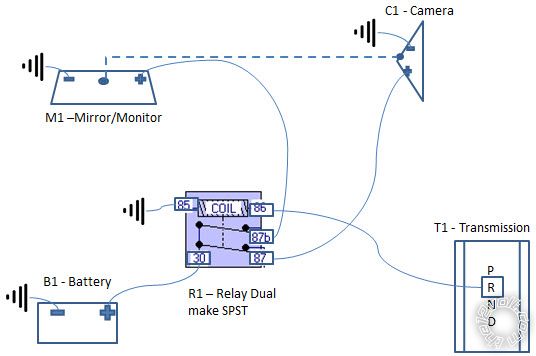The [QUOTE] needs to include the "=userID" (or other word/s??) - eg QUOTE=silentnoise713.
Relays:
Generally only needed if the existing +12V switch or output cannot handle the extra current of the camera. But as Howard said, cameras are usually low current (under 1A) unless perhaps with extra lighting, but even then IR or white LEDs may not add much.
Relays are also used if you need isolation or independence from the source (switch etc) - eg, if the switch switches 9V or 5V or GND and you need 12V for the load (camera).
And they are used if you want a different power source - eg, cleaner +12V from the battery rather than the noisier or lower voltage IGN or ACC or reverse-switch's +12V.
Types of relays:
I guess you know of the
Relays link up the top of this page? That's a good reference. In fact it just taught me what "dual make" referred to (LOL).
Your diagram had 87 & 87b as its contacts which is a "dual output" 87. The dual output terminals might simply be 2 terminals joined internally to the same contact, or each to its own contact as per the
dual make depicted in your diagram.
Electrically a
dual-make relay with 2 internal
arms (from the same terminal 30) and separate output terminals 87 & 87b is the same as a single-arm with 2 output terminals which is the same as a common on-off SPST relay with an external 2-wire join from 87.
So why use a 2-armed or i]dual-make independent output relay? When the supplied circuits are not supposed to be connected together when the relay is off. EG - fuel injector +12V to ECU +12V etc. Isolating diodes could be used instead, but that means a voltage drop of ~0.6V to the loads. Also loads like injectors can take several Amps which mean a big diode and lots of heat.
Anyhow, SPST translates as a common on-off relay, commonly referred to as a 4 pin (relay).
Its contacts are 30 & 87. 87 is aka the NO = Normally Open contact - ie, it
closes and connects to 30 when the relay is energised (12V across coil 86 & 85; by convention +ve to 86 & the more -ve to 85).
The other common type is the SPDT - still a Single Pole, but Double Throw meaning it has an extra NC (Normally Closed) contact which is connected to 30 when the relay is de-energised (ie, its "Normal" state when on the shelf or unpowered).
SPDTs are also called changeover (switches or) relays, and sometimes "5-pin" though I dislike that term because f.ex a dual-make SPST also has 5 pins.
But look for the
relay schematic drawn on most relays. I always used them and NEVER used the DIN numbering 85, 86, 30, 87, 87a etc. (That only started after I joined the12volt! And it will be fun seeing what happens with the newer "micro" relays that use 1, 2, 3, 4, 5 instead!)
In part that is because some dual-output relays may use 87 & 87b instead of 87 & 87. (I even have a Hansa dual-output SPST where the 2nd terminal is labelled 87a which is totally incorrect!! That could lead to disaster if 87 is to +12V and 87a is to GND which is common for some circuits - eg, fans and motors)
Also technically "30" is defined as "
+ from the battery direct". So what if we want to switch IGN or GND - do we need a relay with 15 or 31(abcd) instead or 30? No - it's just a contact/terminal. 87 & 87a can be the "inputs" (say +12V battery and IGN +12V) and 30 can be the output (eg radio +12V).
Sorry, I do get carried away...
Protection diode:
In short, 1N4004 or 1N4007 (whichever available or cheaper; maybe the 007 if priced the same).
But for a bit more info (here I go again!)...
The
reverse biased diode across the relay coil protection aka spike protection or snubber or quenching diodes are typically 1N4004 or 1N4007 diodes. They are often also used as isolation diodes (ie, in series with input or output wires as opposed to
parallel across a relay coil).
The 1N400x series handle up to 1A of current, and that's enough to "snub" the spike from a relay coil rated up to ~500mA.
The last
x digit refers to their (reverse) voltage rating, aka PIV, Peak Inverse Voltage.
The lowest was the 1N4001 (50V) which is fine for series isolation in vehicles, but coils can
spike typically around 200V, so the 1N4004 with 400V PIV is used, else the 1N4007 with 1kV PIV.
These days you tend to only find the 1N4004 or 1N4007, the others having been dropped from production. I suspect one day only the 1N4007 will be available - it does all the others do but tolerates 1,000V, and since they are all the same size and manufacturing process...
You may as well get a pack else several 1N4004s or 007s as they are a common diode and used in many applications - ie, protection and interconnect isolation up to 1A. (The 1N540x series handles 3A, but they are fatter and less convenient.)
Individually 1N400x are usually ~$0.25c each, but can be ~5c each in packs of 20 or 100 etc.
Sorry if all the extra guff is confusing, but I suspect you'll appreciate some demystification and the extra info/tips.
Luckily being non-verbal I suspect at least your
silentnoise is happy.

 Printable version
Printable version
















